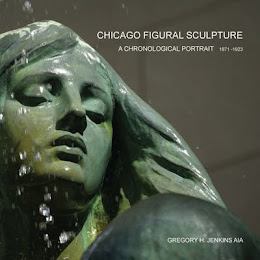During the summer of 1967 I was an intern at the Perkins and Will Partnership. E. Todd Wheeler's name still showed up on pre-printed mylar title sheets. And Larry Perkins (huge, larger than life) occasionally walked the aisles, remembering Crow Island School and Eliel Saarinen. My boss had worked for Graham Anderson Probst and White and had known Ernest Graham personally. Graham, of course had worked for Daniel Burnham.
I've realized the import of this only some forty years later.
The First National Bank of Chicago was an important commission for P&W. Even shared with C.F. Murphy and Associates. In addition to the Bank, there was the Plaza. And beyond that, the entire block bounded by Dearborn, Monroe, Clark and Adams was the proposed site of a 100 story office building.
.
My job in this was presentation draftsman. Locust trees were my specialty. The ones painstakingly stippled with a 4H pencil. Quietly. Like "this" said Carter Manny, who gave us all a quick (humorless?) lesson. The proposal quietly failed -- with the rumored irony being that the Italian Village's unwillingness to sell its property to the assemblage ultimately saved the Marquette Building from demolition.
We officed that summer on the 10th floor of the original Bank, designed by Daniel Burnham in 1902. From some few historic photos, I can see that some of details bear the mark of Peirce Anderson. (Column details recall the entrance to Marshall Field and Company.) But during the months that I worked in their building these names were unknown to me. When the new Bank was completed Burnham's building was demolished. I had not take a single picture.
During recent months of this blog I've been able to reassemble pieces of Peirce Anderson's career as he worked first with Daniel Burnham and then with Ernest Graham. But the earliest years, those turn-of-the-century years elude me. In 1967 I might have said, Ray,did Ernest ever mention Peirce's role in the Banking Room at the First? Ray might have answered. And I might have photographed the room.
.


But, I didn't.
The Clock, now standing in the Plaza is all that remains. (Photographed above.) Along with blurred memories, untold stories, and of course, regrets.




























































